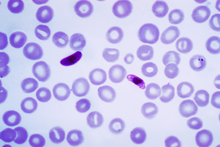Alteration in phospholipid pathways may be a key treatment of parasitic infection
In humans, we utilize an essential nutrient, choline, converting it to phosphocholine and phosphatidylcholine. Phosphatidylcholines (PCs) are important components of biological membranes of both plants and animals. Mechanisms differ in terms of how the PCs are generated. The Kennedy pathway is used in mammals, fungi and some bacteria, while in yeast as well as mammals the Bremer-Greenberg pathway is utilized. Plants, nematodes and parasites such as the protozoan Plasmodium falciparum utilize a third pathway, referred to as the phosphobase methylation pathway. This reaction is catalyzed by the enzyme family phosphoethanolamine methyltransferases (PMTs).
Dangerous parasites

Blood smear of Plasmodium falciparum (gametocytes – sexual forms). From Wikipedia.
Because humans use a different pathway than the parasite P. falciparum, understanding and then disrupting this pathway may be a means to treat malaria, which is caused by the protozoan parasite. P. falciparum is transmitted to humans through the bite of a female Anopheles mosquito, resulting in malaria infection. P. falciparum causes the most dangerous type of malaria and is thus considered the deadliest parasite in humans, causing the World Health Organization to provide a conservative estimate of one million deaths every year.
A plant model system
Researchers at Washington University in St. Louis have been studying the PMT enzymes using the plant model system Arabidopsis thaliana. Researcher Soon Goo Lee, PhD, a postdoctoral fellow, and his advisor, Joseph Jez, PhD, recently published a study in the Journal of Biological Chemistry where they studied the active site of the PMT enzymes (all three forms).
The work by Lee and Jez demonstrated through X-ray crystallography of the PMT enzymes that Arabidopis and P. falciparum have a very similar structure at the active site. Interestingly, the plant enzyme is nearly double the size of the protozoan version. These additional sections enable rearrangement of the enzyme, leading to various chemical reactions. The researchers also learned that the three types of PMTs of Arabidopsis do not all perform the same role depending where in the plant they are localized. Two of the PMTs were located predominantly in the leaves of the Arabidopsis plant. The third version was found to be critical for development of roots and salt tolerance.
Fighting malaria
Lee and Jez have been working on PMTs in parasites and plants for years. They had previously published work functionally and structurally analyzing the P. falciparum PMT enzyme. Using both model systems, the team will keep progressing. In a press release, Lee states, “Understanding the PMT enzyme is key to engineer plants with improved stress tolerance and enhanced nutrients.” Ongoing research will also look to identify inhibitors to the P. falciparum PMT enzyme as a means to treat parasitic disease, such as malaria.
Do you work in parasitology or plant research?
Kerafast has a wide range of products for researching both human and animal parasites as well as plant biology.


